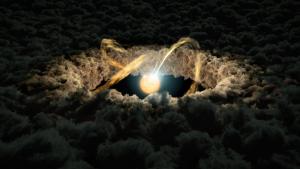Light Echoes Give Clues to Protoplanetary Disk
Imagine you want to measure the size of a room, but it's completely dark. If you shout, you can tell if the space you're in is relatively big or small, depending on how long it takes to hear the echo after it bounces off the wall.

This illustration shows a star surrounded by a protoplanetary disk.
Astronomers use this principle to study objects so distant they can't be seen as more than points. In particular, researchers are interested in calculating how far young stars are from the inner edge of their surrounding protoplanetary disks. These disks of gas and dust are sites where planets form over the course of millions of years.
"Understanding protoplanetary disks can help us understand some of the mysteries about exoplanets, the planets in solar systems outside our own," said Huan Meng, postdoctoral research associate at the University of Arizona, Tucson. "We want to know how planets form and why we find large planets called 'hot Jupiters' close to their stars."
Meng is the first author on a new study using data from NASA's Spitzer Space Telescope and four ground-based telescopes to determine the distance from a star to the inner rim of its surrounding protoplanetary disk.
Making the measurement wasn't as simple as laying a ruler on top of a photograph. Doing so would be as impossible as using a satellite photo of your computer screen to measure the width of the period at the end of this sentence.
Instead, researchers used a method called "photo-reverberation," also known as "light echoes." When the central star brightens, some of the light hits the surrounding disk, causing a delayed "echo." Scientists measured the time it took for light coming directly from the star to reach Earth, then waited for its echo to arrive.
Thanks to Albert Einstein's theory of special relativity, we know that light travels at a constant speed. To determine a given distance, astronomers can multiply the speed of light by the time light takes to get from one point to another.
To take advantage of this formula, scientists needed to find a star with variable emission -- that is, a star that emits radiation in an unpredictable, uneven manner. Our own sun has a fairly stable emission, but a variable star would have unique, detectable changes in radiation that could be used for picking up corresponding light echoes. Young stars, which have variable emission, are the best candidates.
The star used in this study is called YLW 16B and lies about 400 light-years from Earth. YLW 16B has about the same mass as our sun, but at one million years old, it's just a baby compared to our 4.6-billion-year-old home star.
Astronomers combined Spitzer data with observations from ground-based telescopes: the Mayall telescope at Kitt Peak National Observatory in Arizona; the SOAR and SMARTS telescopes in Chile; and the Harold L. Johnson telescope in Mexico. During two nights of observation, researchers saw consistent time lags between the stellar emissions and their echoes in the surrounding disk. The ground-based observatories detected the shorter-wavelength infrared light emitted directly from the star, and Spitzer observed the longer-wavelength infrared light from the disk's echo. Because of thick interstellar clouds that block the view from Earth, astronomers could not use visible light to monitor the star.
Researchers then calculated how far this light must have traveled during that time lag: about 0.08 astronomical units, which is approximately 8 percent of the distance between Earth and its sun, or one-quarter the diameter of Mercury's orbit. This was slightly smaller than previous estimates with indirect techniques, but consistent with theoretical expectations.
Although this method did not directly measure the height of the disk, researchers were able to determine that the inner edge is relatively thick.
Previously, astronomers had used the light echo technique to measure the size of accretion disks of material around supermassive black holes. Since no light escapes from a black hole, researchers compare light from the inner edge of the accretion disk to light from the outer edge to determine the disk size. This technique is also used to measure the distance to other features near the accretion disk, such as dust and the surrounding fast-moving gas.
While light echoes from supermassive black holes represent delays of days to weeks, scientists measured the light echo from the protoplanetary disk in this study to be a mere 74 seconds.
The Spitzer study marks the first time the light echo method was used in the context of protoplanetary disks.
"This new approach can be used for other young stars with planets in the process of forming in a disk around them," said Peter Plavchan, co-author of the study and assistant professor at Missouri State University in Springfield.
Source: Jet Propulsion Laboratory
- 334 reads
Human Rights
Ringing FOWPAL’s Peace Bell for the World:Nobel Peace Prize Laureates’ Visions and Actions

Protecting the World’s Cultural Diversity for a Sustainable Future

The Peace Bell Resonates at the 27th Eurasian Economic Summit

Declaration of World Day of the Power of Hope Endorsed by People in 158 Nations

Puppet Show I International Friendship Day 2020

